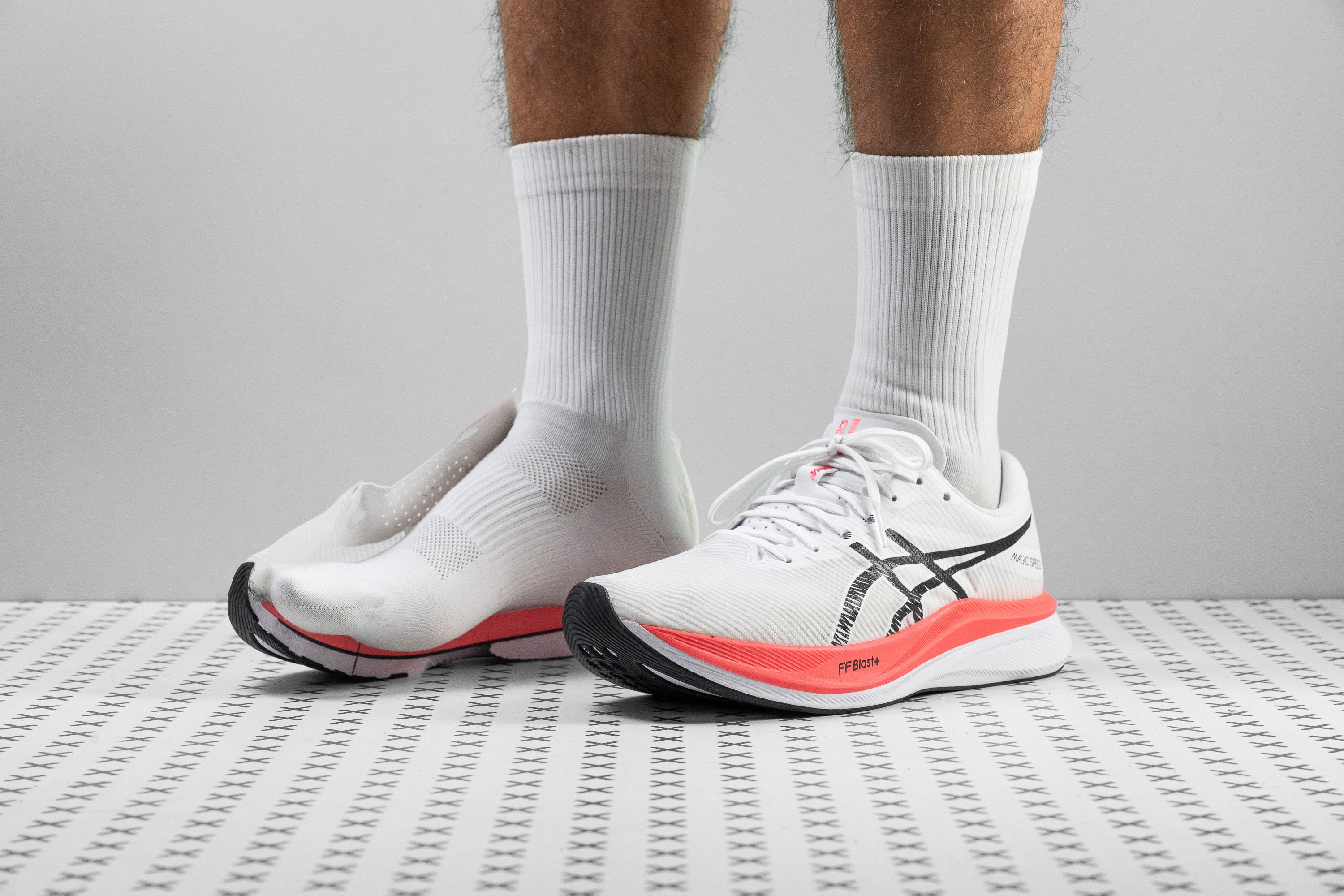Our verdict
Pros
- Perfectly balanced midsole
- Ample cushioning for extended runs
- Highly breathable monomesh upper
- Attractively priced
- Exceptionally lightweight
- Grippy and long-lasting outsole
- Great deal at $160 for a carbon-plated shoe
Cons
- Likely too narrow for some
- Midsole could use more energy return
- Upper could be more durable
- Needs better energy return
Audience verdict
- Top 6% in road running shoes
- Top 16% in ASICS running shoes
Comparison
The most similar running shoes compared
+ + Add a shoe | |||||
|---|---|---|---|---|---|
| Audience score | 91 Superb! | 90 Superb! | 92 Superb! | 89 Great! | |
| Price | $160 | $230 | $170 | $160 | |
| Pace | Tempo | CompetitionTempo | CompetitionTempo | Tempo | |
| Shock absorption | High | High | High | High | |
| Energy return | Moderate | High | Moderate | Moderate | |
| Traction | High | High | High | High | |
| Arch support | Neutral | Neutral | Neutral | Neutral | |
| Weight lab Weight brand | 7.4 oz / 211g 7.8 oz / 220g | 7.2 oz / 204g 7.4 oz / 209g | 8.4 oz / 237g 8.5 oz / 242g | 9.5 oz / 268g 9.5 oz / 269g | |
| Lightweight | ✓ | ✓ | ✓ | ✗ | |
| Drop lab Drop brand | 9.8 mm 7.0 mm | 10.6 mm 8.0 mm | 9.6 mm 8.0 mm | 10.1 mm 10.0 mm | |
| Strike pattern | HeelMid/forefoot | Heel | HeelMid/forefoot | Heel | |
| Size | Slightly small | True to size | True to size | Slightly small | |
| Midsole softness | Soft | Soft | Soft | Soft | |
| Difference in midsole softness in cold | Small | Normal | Small | Normal | |
| Toebox durability | Bad | Bad | Good | Decent | |
| Heel padding durability | Decent | Good | Good | Decent | |
| Outsole durability | Good | Decent | Good | Decent | |
| Breathability | Moderate | Moderate | Breathable | Moderate | |
| Width / fit | Narrow | Medium | Medium | Narrow | |
| Toebox width | Medium | Narrow | Medium | Narrow | |
| Stiffness | Stiff | Stiff | Stiff | Stiff | |
| Torsional rigidity | Stiff | Stiff | Stiff | Stiff | |
| Heel counter stiffness | Flexible | Flexible | Flexible | Flexible | |
| Plate | Carbon plate | Carbon plate | Carbon plate | Carbon plate | |
| Rocker | ✓ | ✓ | ✓ | ✗ | |
| Heel lab Heel brand | 36.3 mm 36.0 mm | 39.2 mm 40.0 mm | 42.5 mm 43.5 mm | 37.4 mm 39.0 mm | |
| Forefoot lab Forefoot brand | 26.5 mm 29.0 mm | 28.6 mm 32.0 mm | 32.9 mm 35.5 mm | 27.3 mm 29.0 mm | |
| Widths available | Normal | Normal | NormalWide | NormalWide | |
| Orthotic friendly | ✓ | ✓ | ✓ | ✓ | |
| Season | All seasons | All seasons | SummerAll seasons | All seasons | |
| Removable insole | ✓ | ✓ | ✓ | ✓ | |
| Ranking | #33 Top 6% | #38 Top 11% | #13 Top 4% | #115 Top 32% | |
| Popularity | #339 Bottom 48% | #50 Top 14% | #82 Top 23% | #60 Top 17% |
Who should buy
We believe the ASICS Magic Speed 3 is an excellent choice for:
- Runners seeking a similar experience to the ASICS Metaspeed Sky+/Edge+ but at a more affordable price point, avoiding the $250 tag.
- Anyone searching for a feather-light shoe focused on tempo runs or faster paces.
- Those exploring their first carbon-plated shoe and aiming to spend the least amount possible.

Who should NOT buy
The Magic Speed 3 presents a great mix of features at a reasonable price, but we think it may not be suitable for every runner.
For those chasing peak performance, we know a carbon plate alone isn't enough. It should be complemented by a top-tier foam offering substantial energy return, and unfortunately, FF Blast+ doesn't quite make that cut.
While you might have to spend a bit more, we believe that faster alternatives like the Nike Vaporfly 3, ASICS Metaspeed Edge+, or Adidas Adizero Adios Pro 3 are worth considering.

Additionally, the Magic Speed 3 might not be the best fit for runners with wide feet due to its very narrow midfoot. If you're looking for an uptempo shoe with a wider upper, the ASICS Superblast or the Saucony Endorphin Speed 3 are excellent alternatives to explore.
Cushioning
Shock absorption
The Magic Speed 3 delivers impressive shock absorption in the heel with 139 SA, making it a strong option for heavier heel strikers or anyone looking for extra muscle and joint protection during long runs.

| Magic Speed 3 | 139 SA |
| Average | 129 SA |
Energy return
While the Magic Speed 3 includes some supershoe elements like a carbon plate, it doesn’t quite belong in that elite group—mainly because of the foam ASICS used.
FF Blast+ is a comfortable and durable compound that handles daily runs well, but it lacks the lively bounce needed for peak performance. The MS3 scored only 56.5% in our ASTM F1976 test, making it a poor choice for runners who prioritize speed above all else.
| Magic Speed 3 | 56.5% |
| Average | 58.5% |
Heel stack
The Magic Speed 3 is taller than it appears, as we were surprised to measure a generous 36.3 mm in the heel.
This makes the shoe a delight for heel strikers, and it even allows for comfortable use on long runs if necessary.
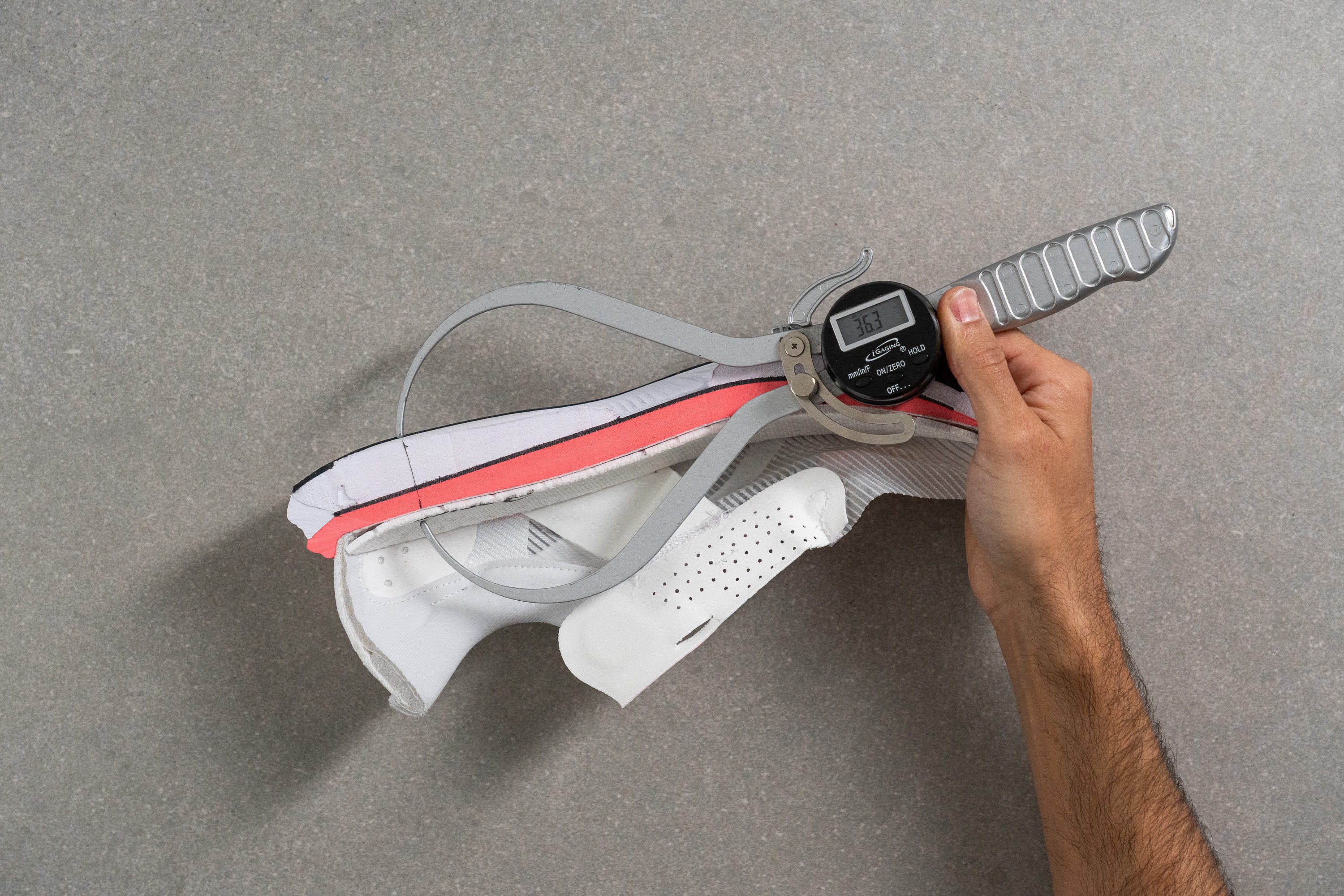
| Magic Speed 3 | 36.3 mm |
| Average | 34.7 mm |
Forefoot stack
The forefoot turned out to be a bit thinner than we expected, yet it's still thicker than the average at 26.5 mm.
This means there's plenty of cushioning underfoot for those who strike the ground with the front part of their feet.
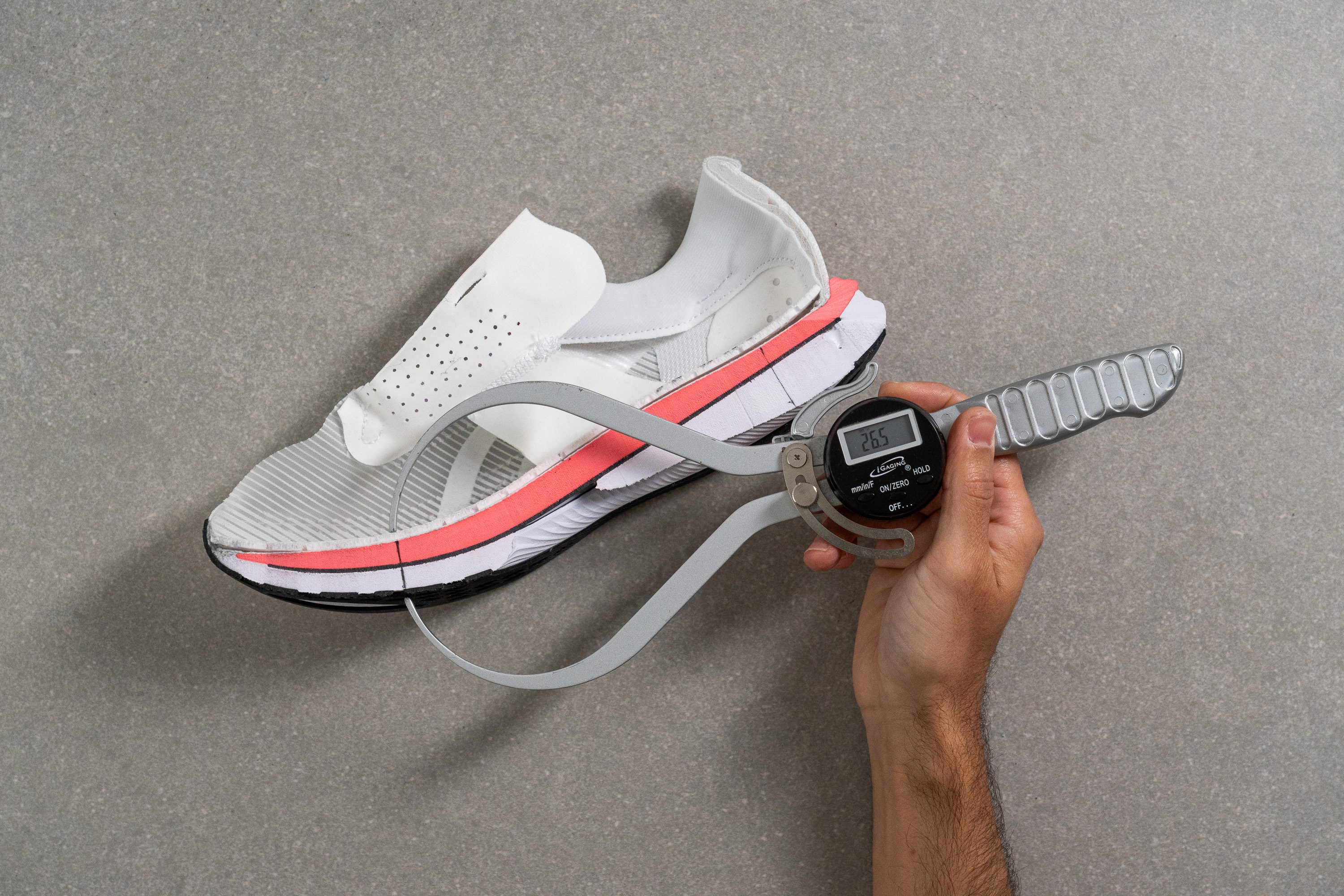
| Magic Speed 3 | 26.5 mm |
| Average | 26.1 mm |
Drop
ASICS claims the shoe has a 7-mm offset, but following World Athletics' official guidelines, we measured it at 9.8 mm.
Despite this, the shoe feels very universal, suitable for all types of footstrikes, much like a daily training shoe.
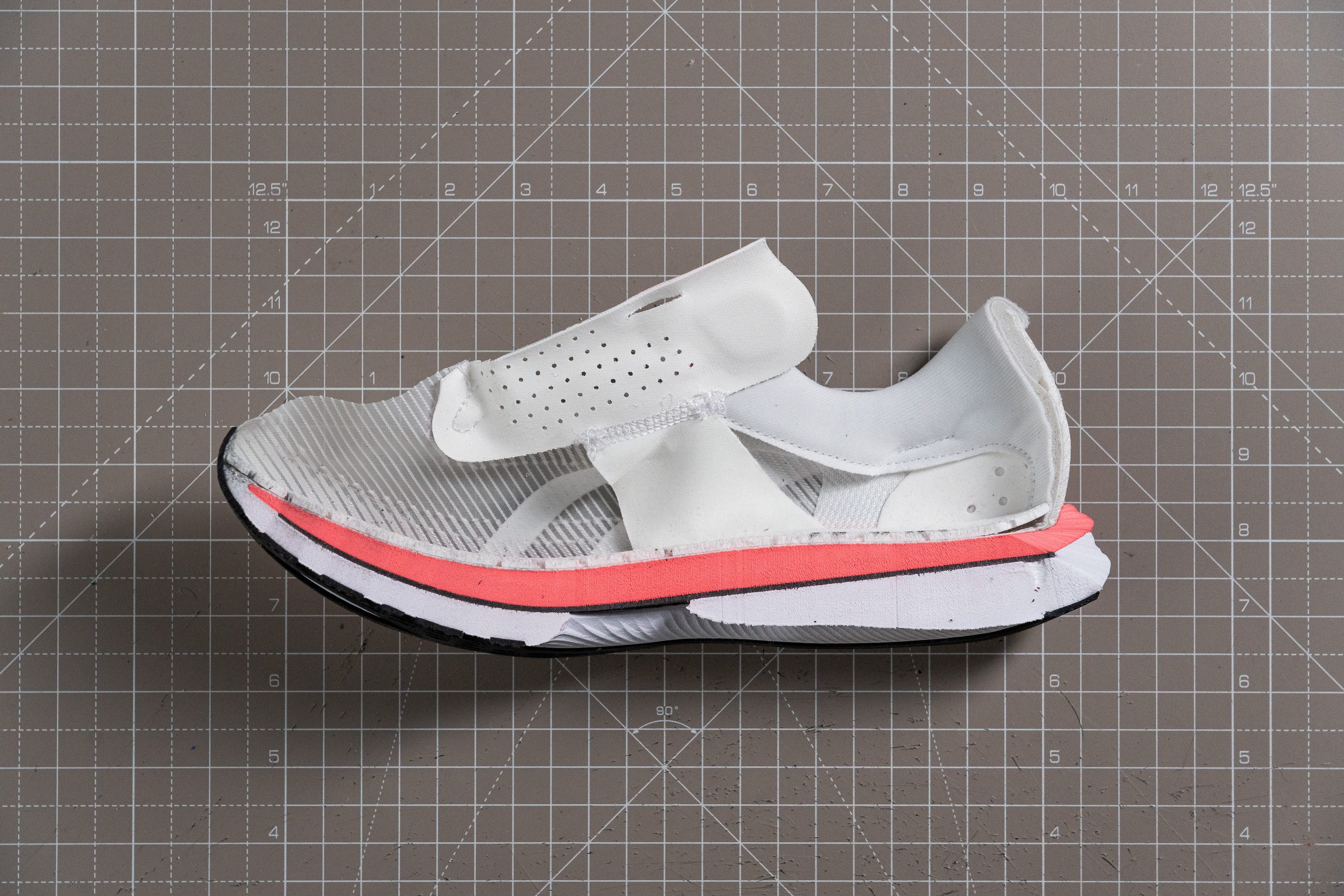
| Magic Speed 3 | 9.8 mm |
| Average | 8.6 mm |
Midsole softness
We mentioned earlier that this shoe is $90 cheaper than its Metaspeed counterparts, and here's where most of the savings come in.
Instead of the PEBA-based, super-bouncy FF Turbo foam, the Magic Speed 3 uses a dual-layer configuration of FF Blast+. This is a mix of EVA and OBC, the same as in the daily trainer ASICS Novablast 4. And it's really different from the firmer feel that the Magic Speed 2 delivered.
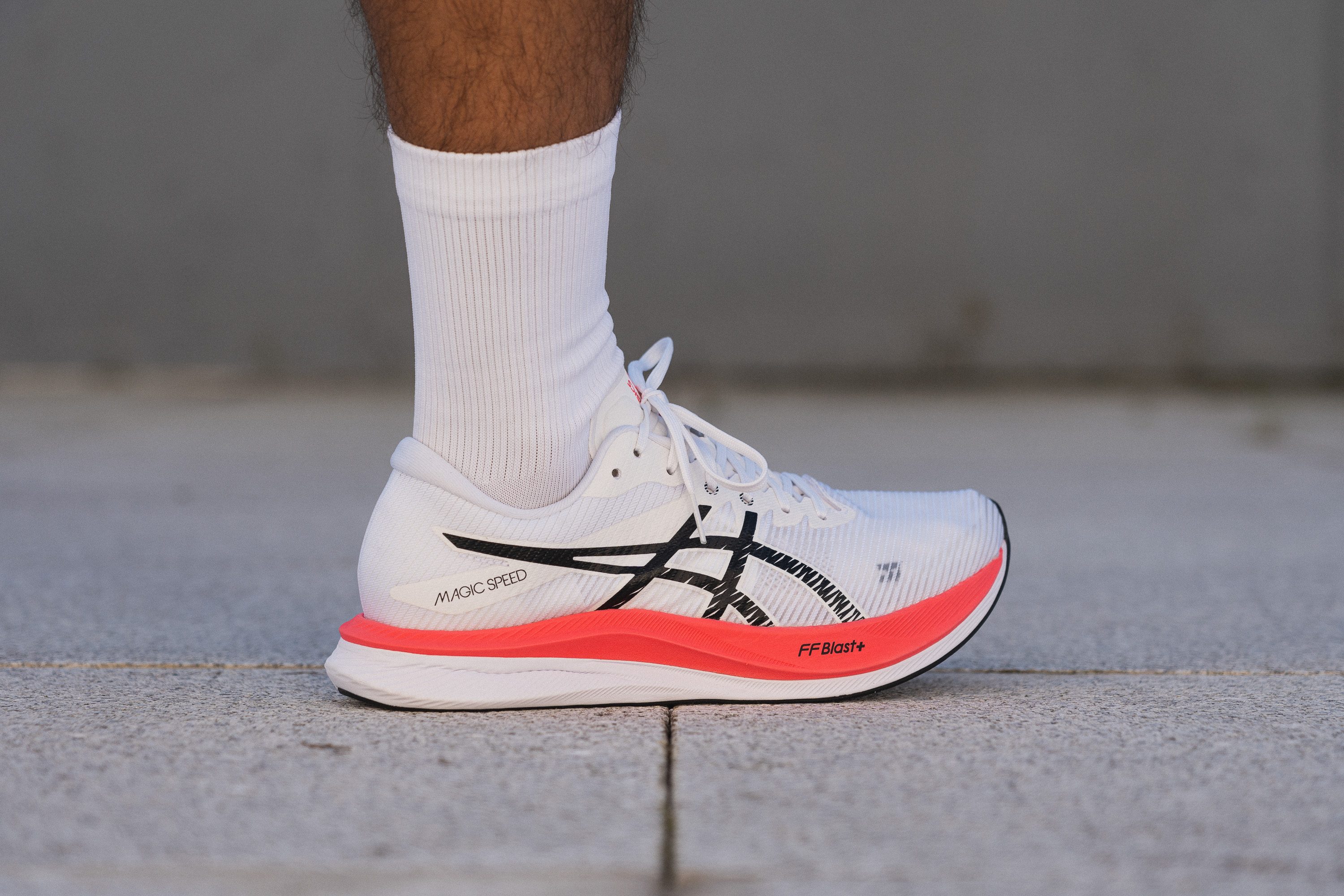
FF Blast+ is a pretty good foam with a soft feel, clocking in at 18.3 HA in the bottom layer. However, don't expect a super energetic foam, as that's not what FF Blast+ is about. But for training purposes, and even for racing for many people, it's more than sufficient.

| Magic Speed 3 | 18.3 HA |
| Average | 20.4 HA |
Secondary foam softness
The top layer (red) is slightly firmer to enhance stability at 21.1 HA, and it sits above the carbon plate. This combination works really well because the softer foam beneath the plate, in direct contact with the ground, provides a more comfortable ride.
All in all, the FF Blast+, combined with the carbon fiber plate, offers a great pop at both aerobic and tempo paces.

| Magic Speed 3 | 21.1 HA |
| Average | 22.6 HA |
Size and fit
Size
ASICS Magic Speed 3 fits slightly small (68 votes).
Width / Fit
With its slim platform, we anticipated a tight-fitting upper. But we couldn't be sure until we whipped out our calipers.
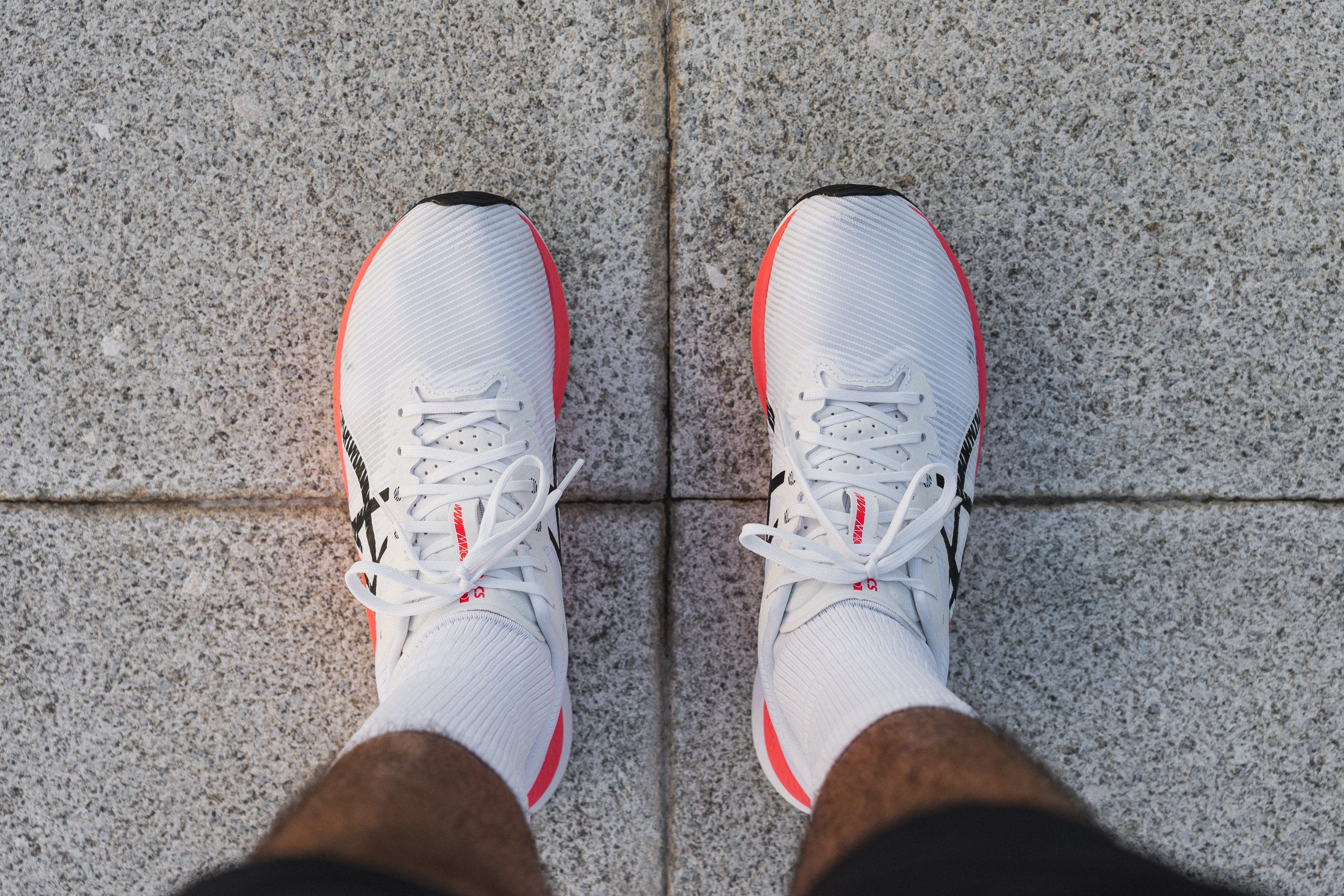
Measuring at 93.2 mm, the Magic Speed 3 offers a race-like fit, perfect for those with narrow feet. If you have average-sized feet, it's still manageable, provided you're okay with a snug, performance-oriented upper.
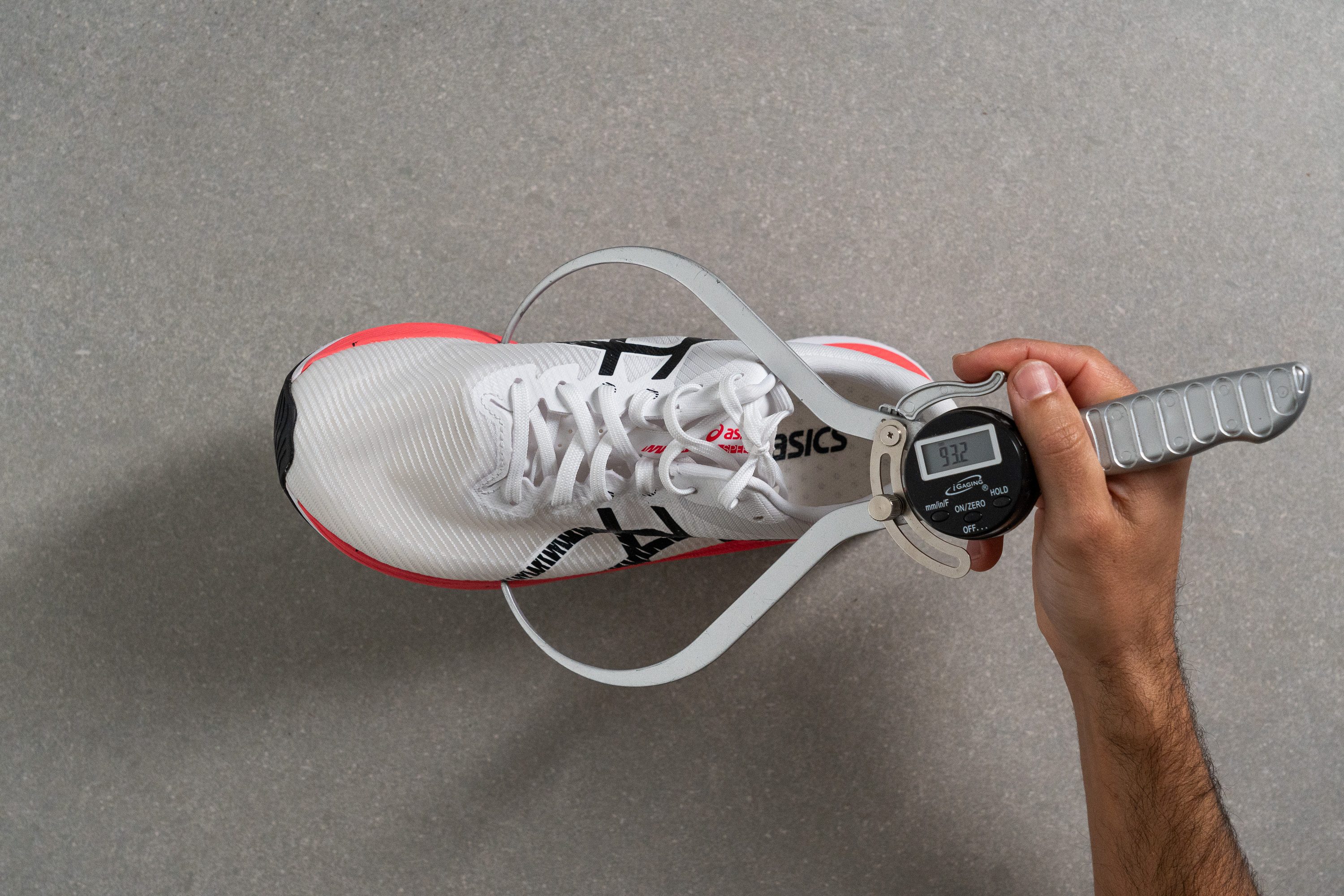
This test follows an older methodology, which is why you don't see recently tested shoes in the chart. Results from different methodologies can not be compared.
| Magic Speed 3 | 93.2 mm |
| Average | 98.5 mm |
Toebox width
Runners with average-width feet can comfortably sport the Magic Speed 3, thanks to ASICS making the big toe area wider than the average, at 79.4 mm.
This creates a unique fit that suits many runners—snug in the midfoot but spacious in the toes. It's also ideal for running at marathon pace and faster.
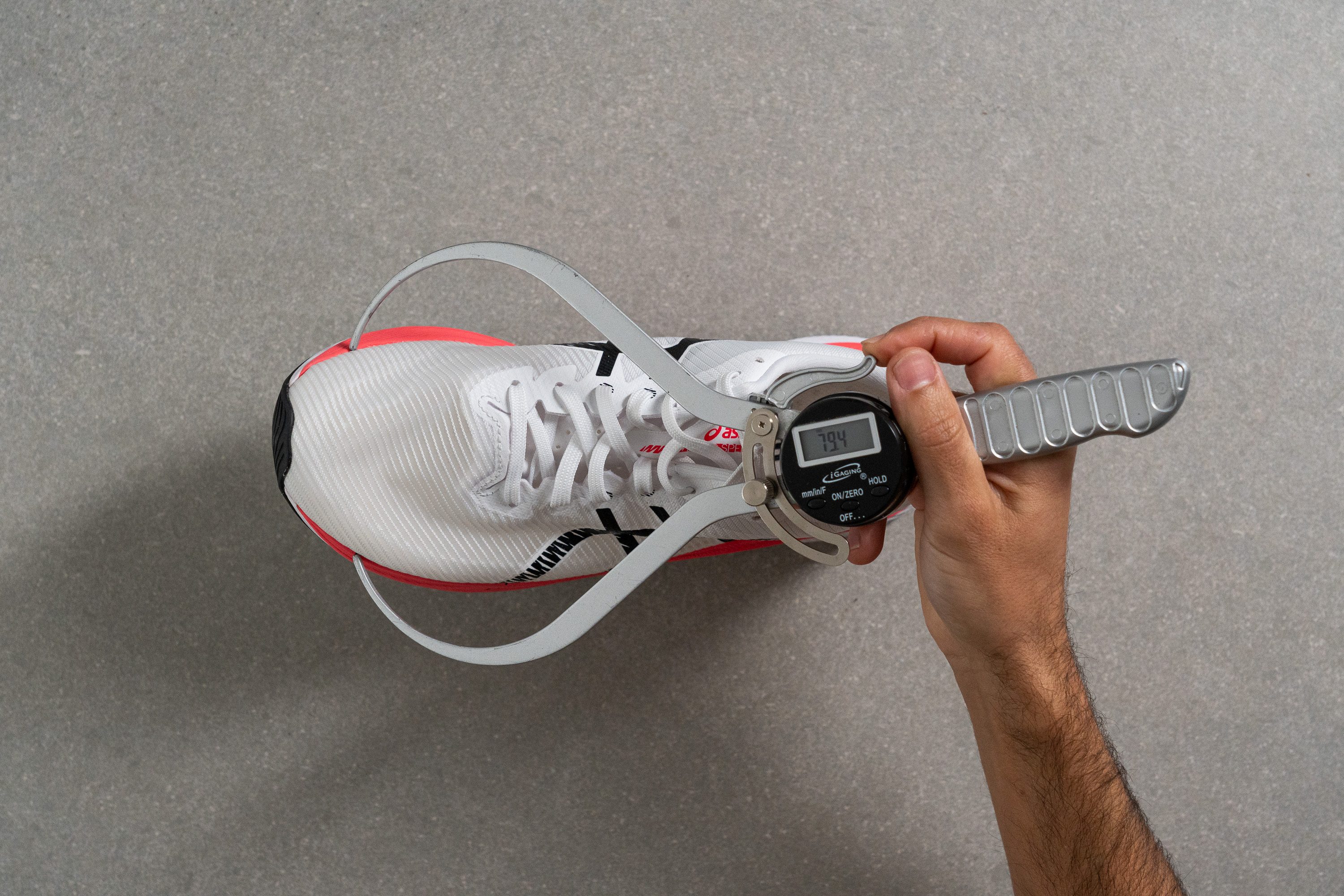
This test follows an older methodology, which is why you don't see recently tested shoes in the chart. Results from different methodologies can not be compared.
| Magic Speed 3 | 79.4 mm |
| Average | 78.4 mm |
Traction / Grip
Traction test
Traction in the ASICS Magic Speed 3 is outstanding. We discovered the same elite-level rubber used in the Metaspeed series, paired with a superb 0.77 score in our wet-grip test—placing it among the top tempo shoes for all-weather reliability.
| Magic Speed 3 | 0.77 |
| Average | 0.48 |
Outsole design
The outsole boasts good rubber coverage on both sides and in the forefoot. However, it also aims for weight reduction, featuring plenty of exposed foam in the midfoot.
The ASICS Magic Speed 3 features a partially covered outsole with strategic placement of black rubber in the heel, lateral edge, and forefoot zone. We also found that the forefoot rubber is perforated with circular holes to save weight while preserving structure.
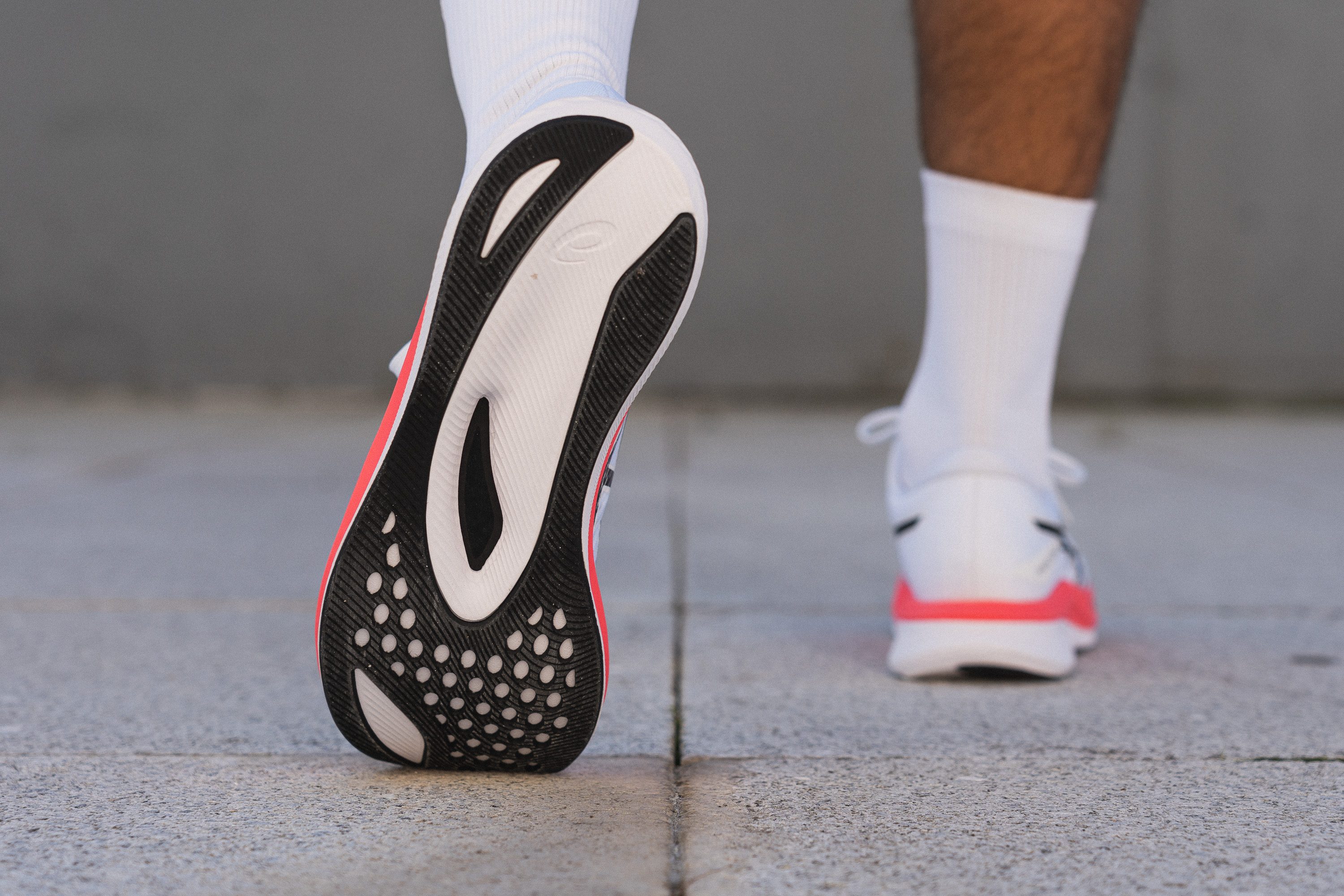
Flexibility / Stiffness
We found that the carbon fiber plate inside the Magic Speed 3 delivers supershoe-level stiffness. ASICS clearly designed this model with fast-paced runs in mind, and our test confirmed it with a stiff 18.2N reading.
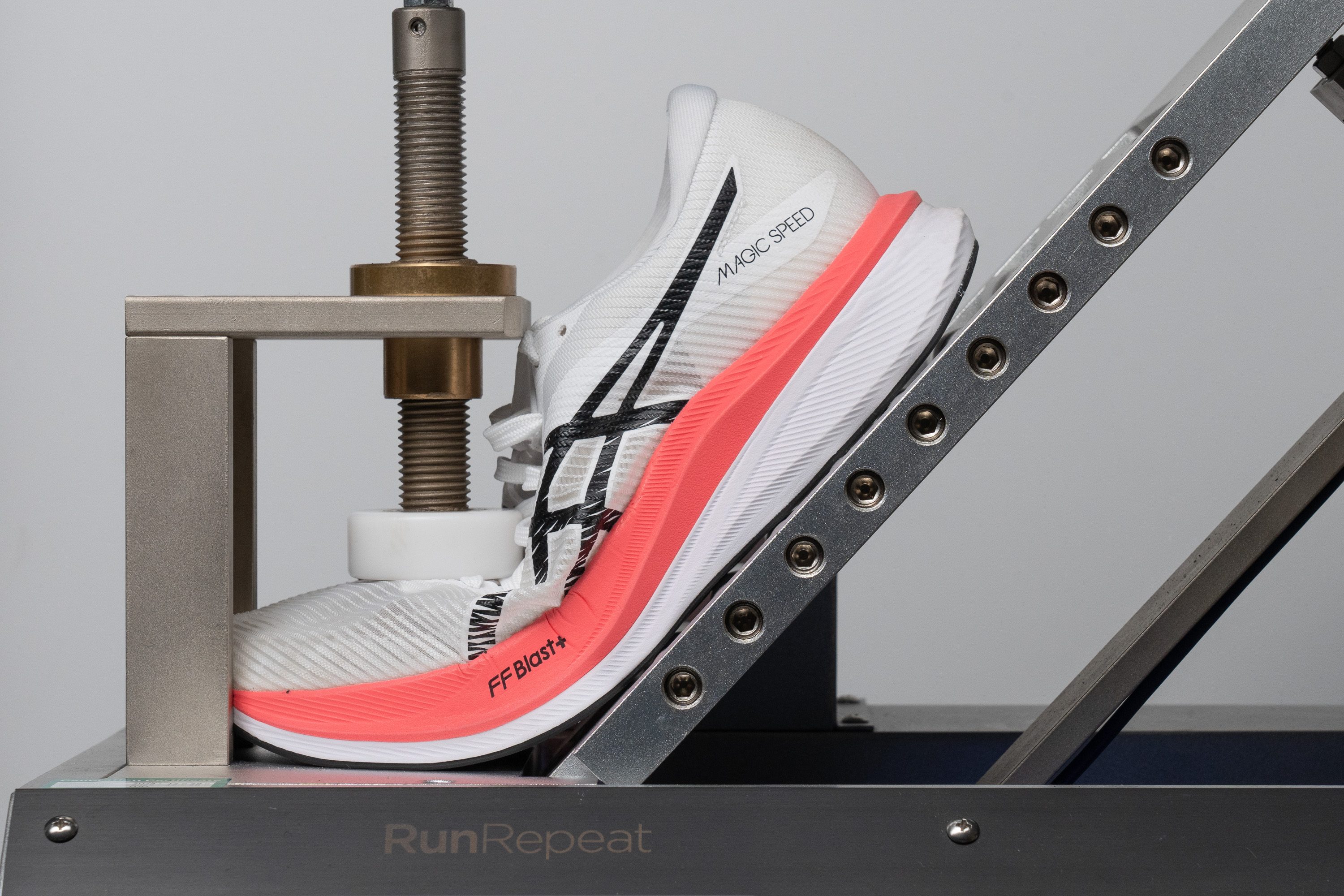
| Magic Speed 3 | 18.2N |
| Average | 15.3N |
Stiffness in cold
Under cold temperatures, the shoe changed slightly. We re-tested it after spending 20 minutes in our freezer and got a pretty similar result at 35.6N.
| Magic Speed 3 | 35.6N |
| Average | 36.2N |
Stiffness in cold (%)
That's just a 13.4% difference, once again highlighting the impressive performance of the FF Blast+ foam.
| Magic Speed 3 | 13% |
| Average | 33% |
Weight
Weighing in at just 7.4 oz (211g), ASICS did an incredible job keeping the shoe under 8 ounces.
In fact, it's a mere 0.17 oz heavier than the Metaspeed Sky+, which is quite a feat. This is especially impressive considering it has more rubber on the outsole and extra padding in the upper.
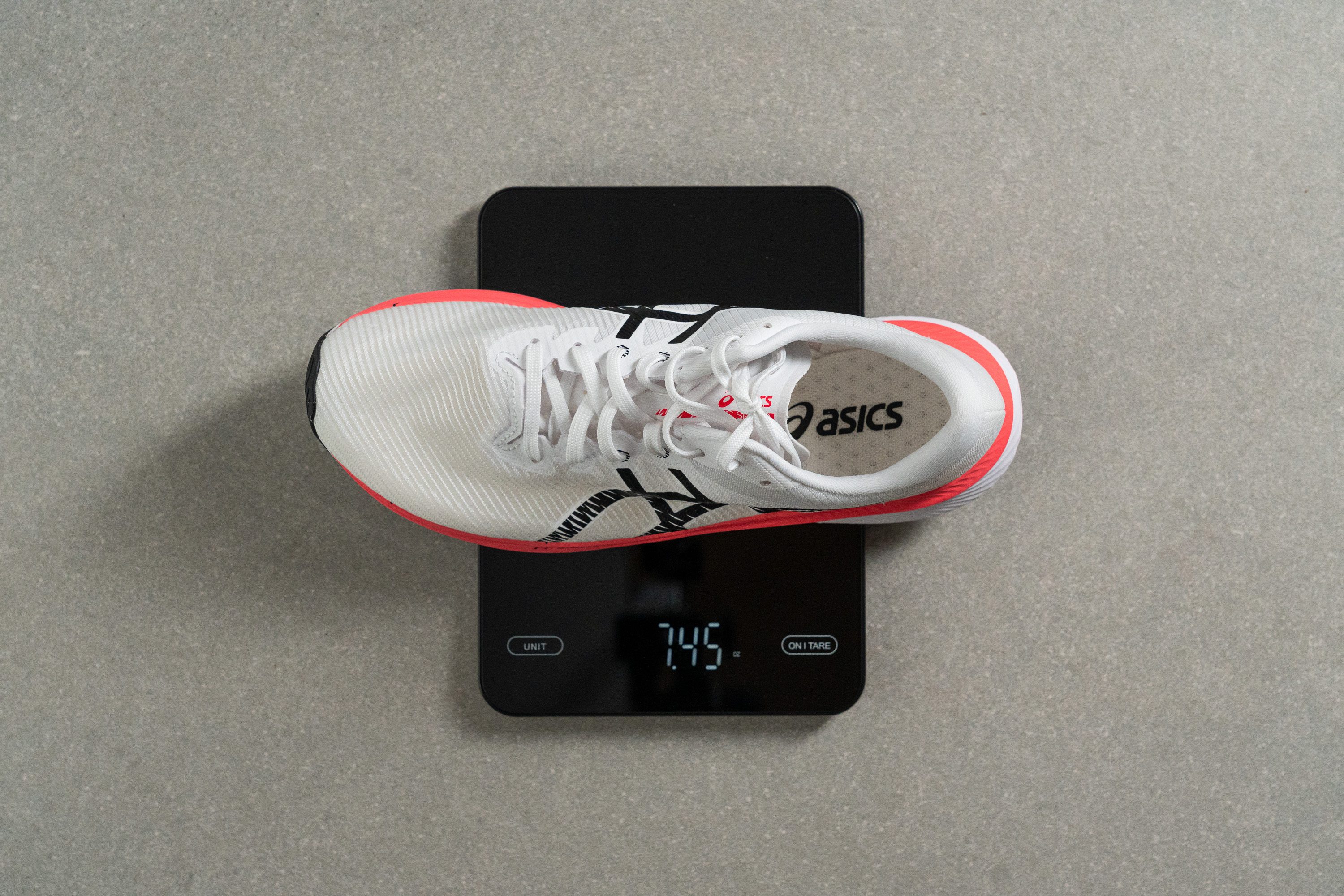
| Magic Speed 3 | 7.4 oz (211g) |
| Average | 9.3 oz (264g) |
Breathability
We were totally sure that the Magic Speed 3 would excel in our breathability test. Right from unboxing, the upper appeared super thin to us, promising great airflow. But we're not here to make guesses—we're here to do lab tests.
When we pumped smoke into the MS3 with our machine, we discovered that the upper is incredibly breathable, even without having large ventilation holes. That's a good 4/5 for us.
A major plus of this design is the overall excellent airflow throughout the shoe, not just in the toebox, as our light test showed. This means the midfoot area stays cool, which is fantastic.
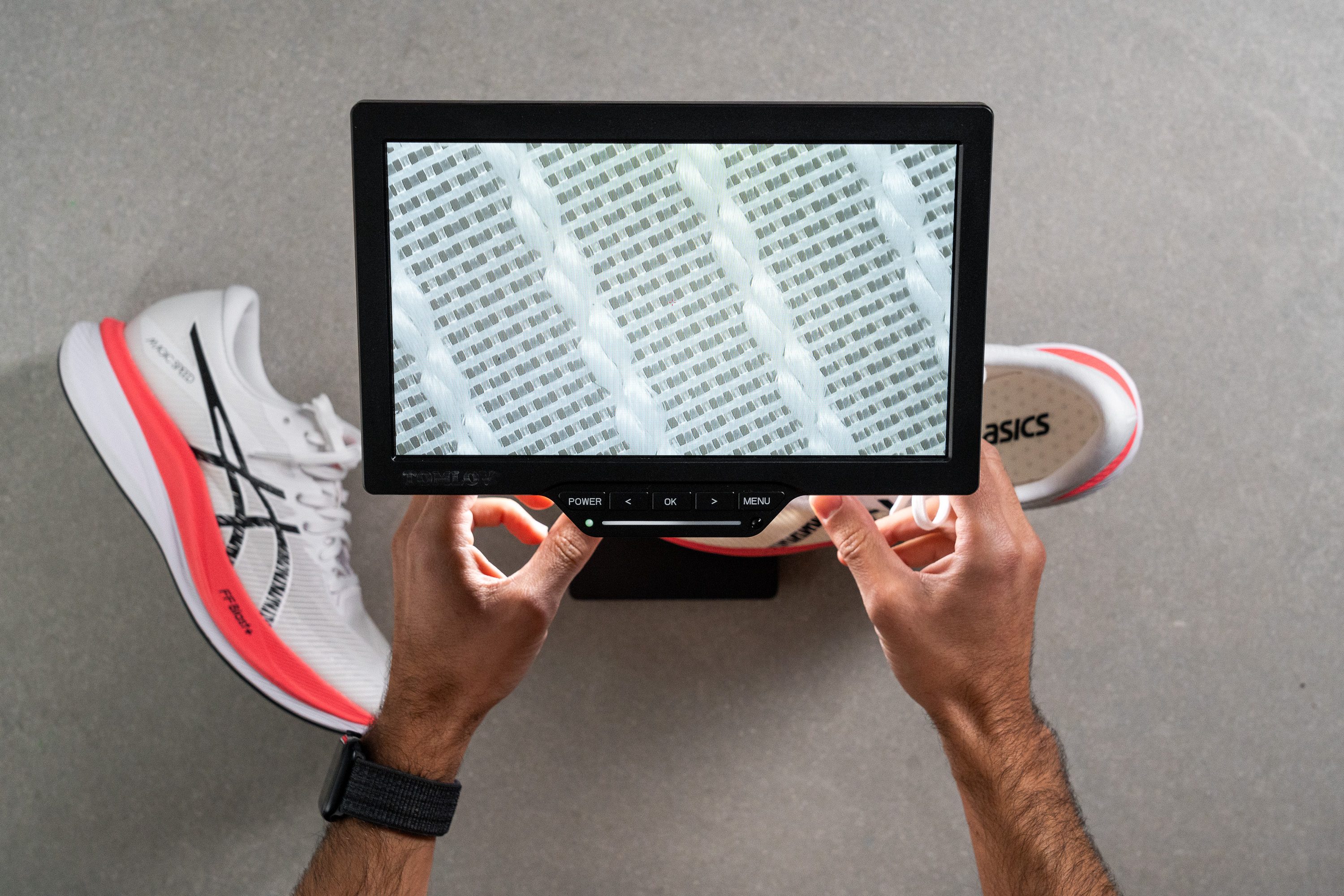
To really get why the shoe breathes so well and evenly, we headed over to our microscope. The sight was astonishing—a single-layer mesh with thousands of mini-ventilation holes in the upper. We were totally impressed.
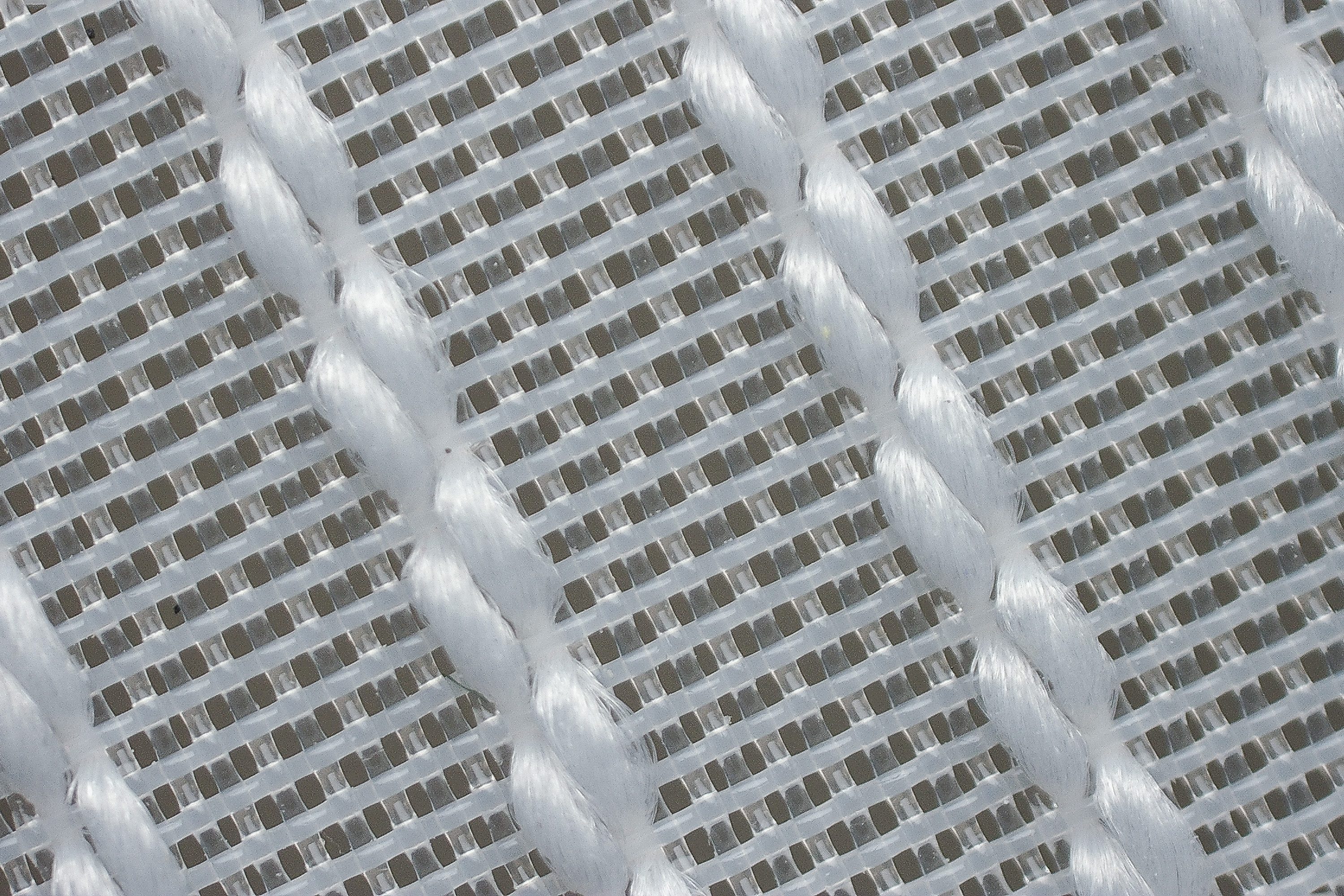
This is one of the most outstanding uppers we've encountered in the lab, and it looks absolutely amazing under the microscope.
And here's the kicker—ASICS managed to vary the upper's density in a single piece by tweaking the thread patterns. The closer you get to the toebox, the thinner it becomes. Simply awesome.
| Magic Speed 3 | 4 |
| Average | 3.7 |
Stability
Lateral stability test
In our opinion, the ASICS Magic Speed 3 is a neutral shoe, yet it includes features that add a bit more stability, like midfoot sidewalls. These aren't too noticeable but offer great support.
Overall, we think those needing slight stability can comfortably use it for short to moderate distances or track workouts.
Torsional rigidity
Boasting a full-length carbon plate, we anticipated maximum torsional rigidity, and that's exactly what the MS3 delivered. We had to give it a 5/5 rating since it's nearly impossible to flex or bend.
The carbon plate brings both advantages and drawbacks. It makes the shoe very stable and provides a peppy ride, but it can also be too uncomfortable for long runs. This is especially true for those sensitive to rigid elements, like runners with Morton's neuroma or similar issues.
| Magic Speed 3 | 5 |
| Average | 3.5 |
Heel counter stiffness
The heel is actually the opposite of stiff, scoring just 2/5 in our manual assessment. Despite this, we found that the MS3 delivers a solid heel lockdown, something that ASICS has consistently excelled at in their latest models.
| Magic Speed 3 | 2 |
| Average | 2.9 |
Midsole width - forefoot
At this point in our thorough lab review, we were wondering—how on earth did ASICS manage to keep the shoe's weight so low with such a high stack height and more rubber than the Metaspeeds?
Well, here's the answer. At 104.9 mm, the shoe is quite narrow, and that's where its agility and lightness come from. Because of this, runners who prefer wider landing platforms should probably avoid this one and look for something like the Hoka Mach X.

| Magic Speed 3 | 104.9 mm |
| Average | 114.3 mm |
Midsole width - heel
The heel follows the same design approach, measuring just 85.1 mm.
These dimensions, along with the carbon plate, are also why this shoe is less suited for everyday runs and more geared towards faster, intense workouts.
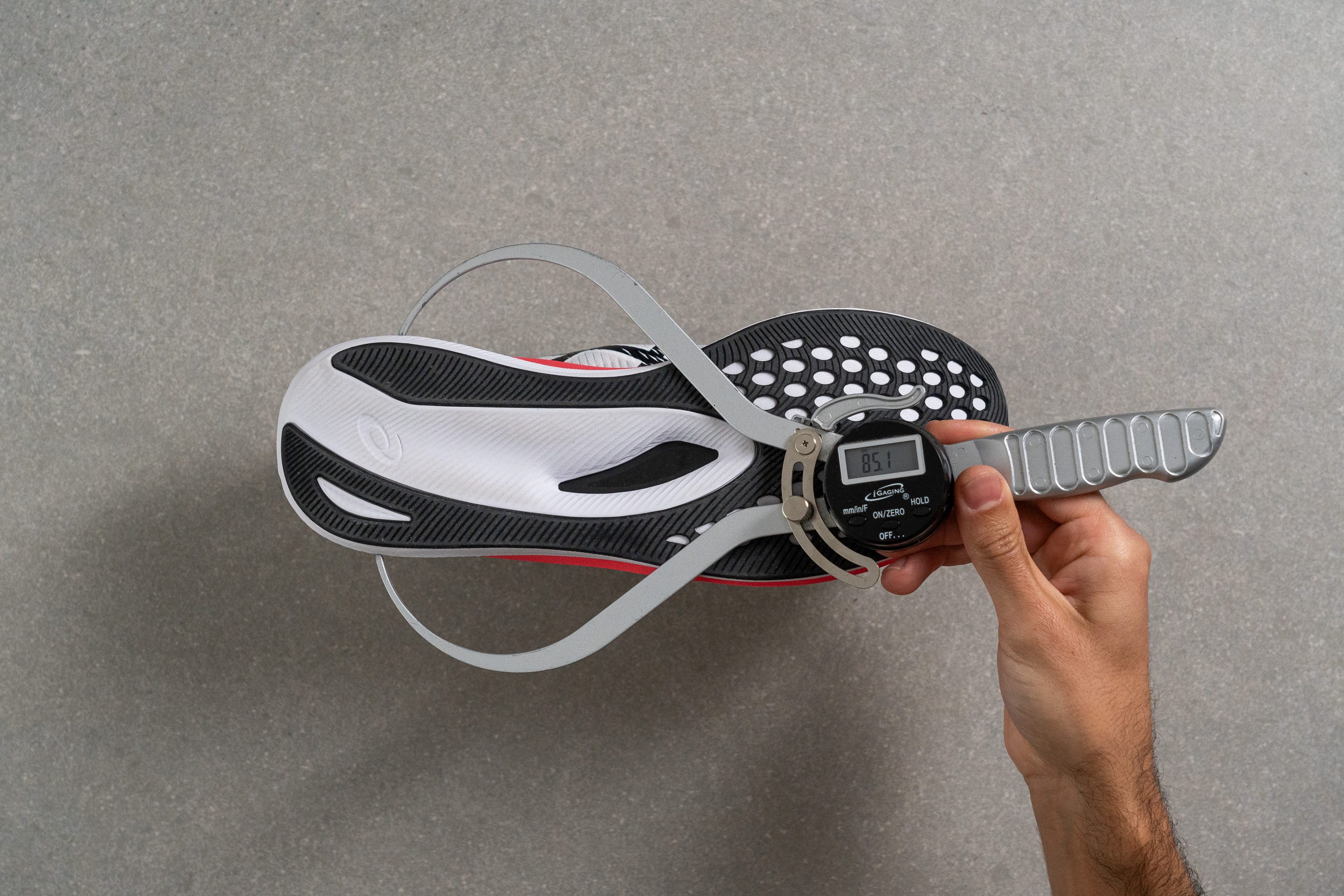
| Magic Speed 3 | 85.1 mm |
| Average | 90.7 mm |
Durability
Toebox durability
Given the incredibly thin mesh, we were worried about the durability test even before firing up the Dremel in the lab.
But, we had to face it. As expected, it's a disappointing 1/5—the upper was totally wrecked after the test.
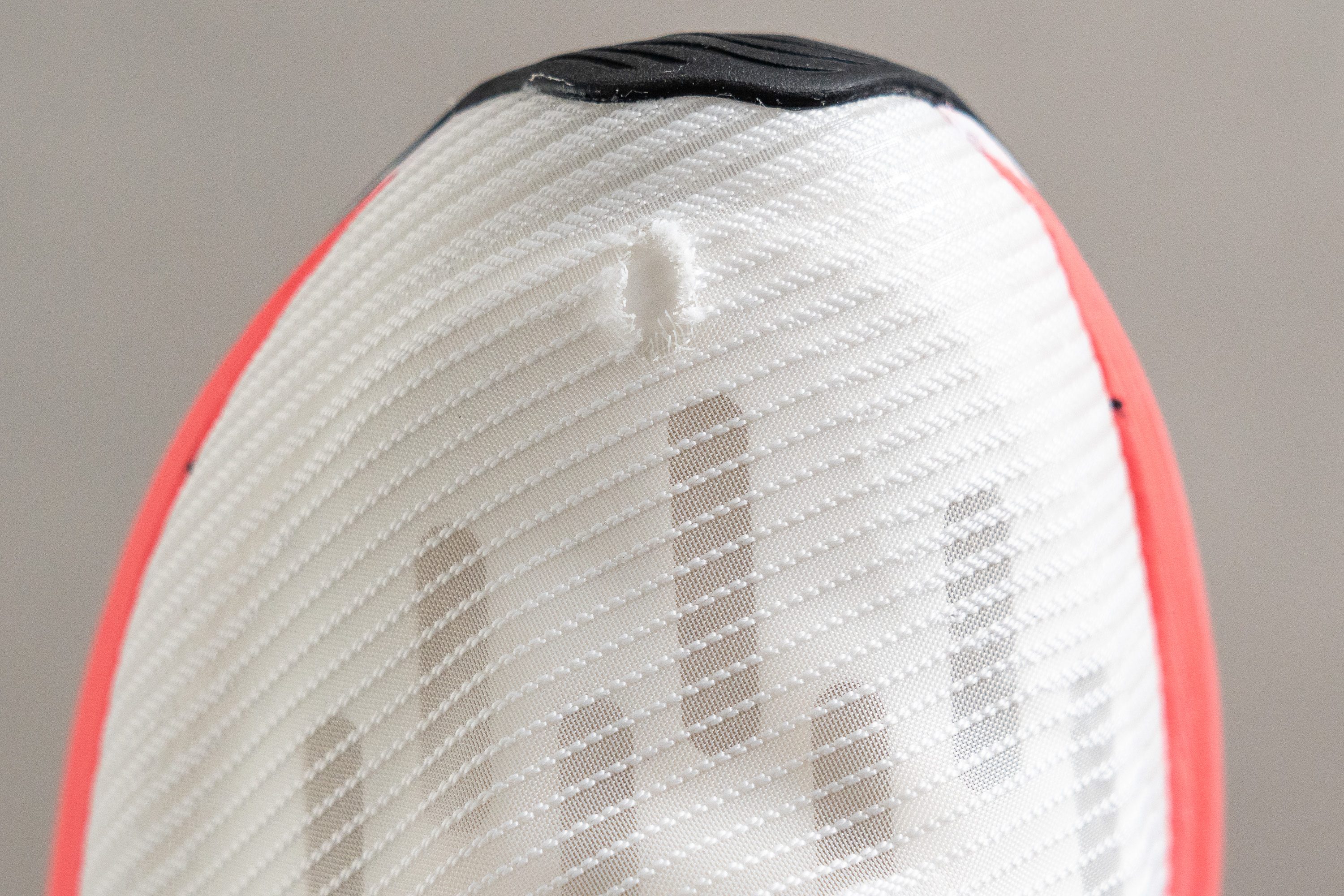
| Magic Speed 3 | 1 |
| Average | 2.6 |
Heel padding durability
We then shifted our focus to the heel, hoping for a better outcome—and we weren't disappointed.
With a solid 3/5, this area performed significantly better than the toebox. We're confident you won't see any early wear and tear here.
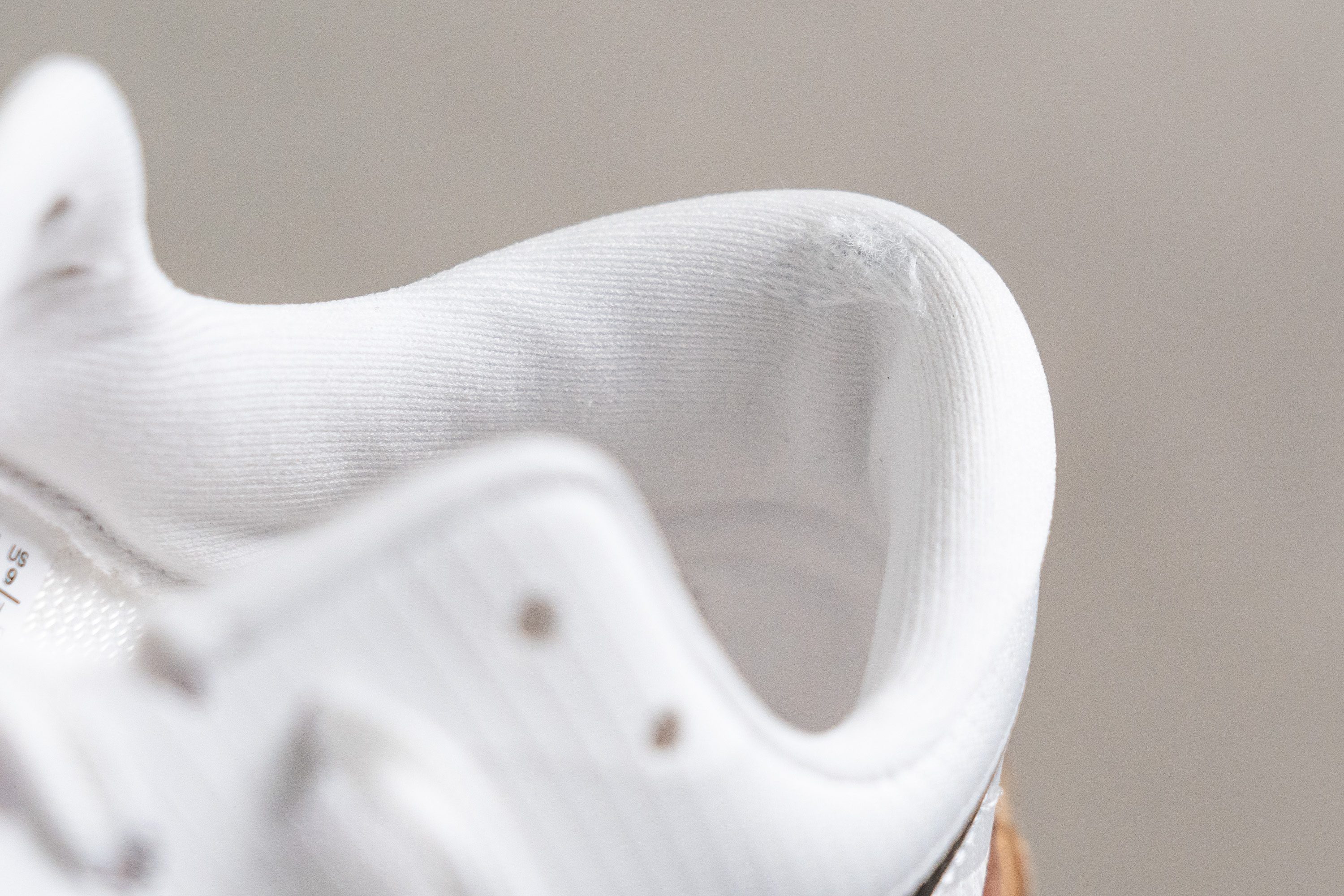
| Magic Speed 3 | 3 |
| Average | 3.4 |
Outsole durability
To assess the outsole's durability, we fired up the Dremel for the third time.
Once the Dremel had worked its magic at 10K RPM, we noticed a minimal 0.5-mm indentation—an exceptional result.
This leaves us with one clear thought—ASICS used the same world-class rubber found in their $250 racing shoes. And the best part? You get it for $90 less.

| Magic Speed 3 | 0.5 mm |
| Average | 1.1 mm |
Outsole thickness
In the outsole, we found 2.4 mm of rubber, which seems more than enough to last the entire lifespan of the shoe. It's also 0.3 mm thicker than on the Edge+.
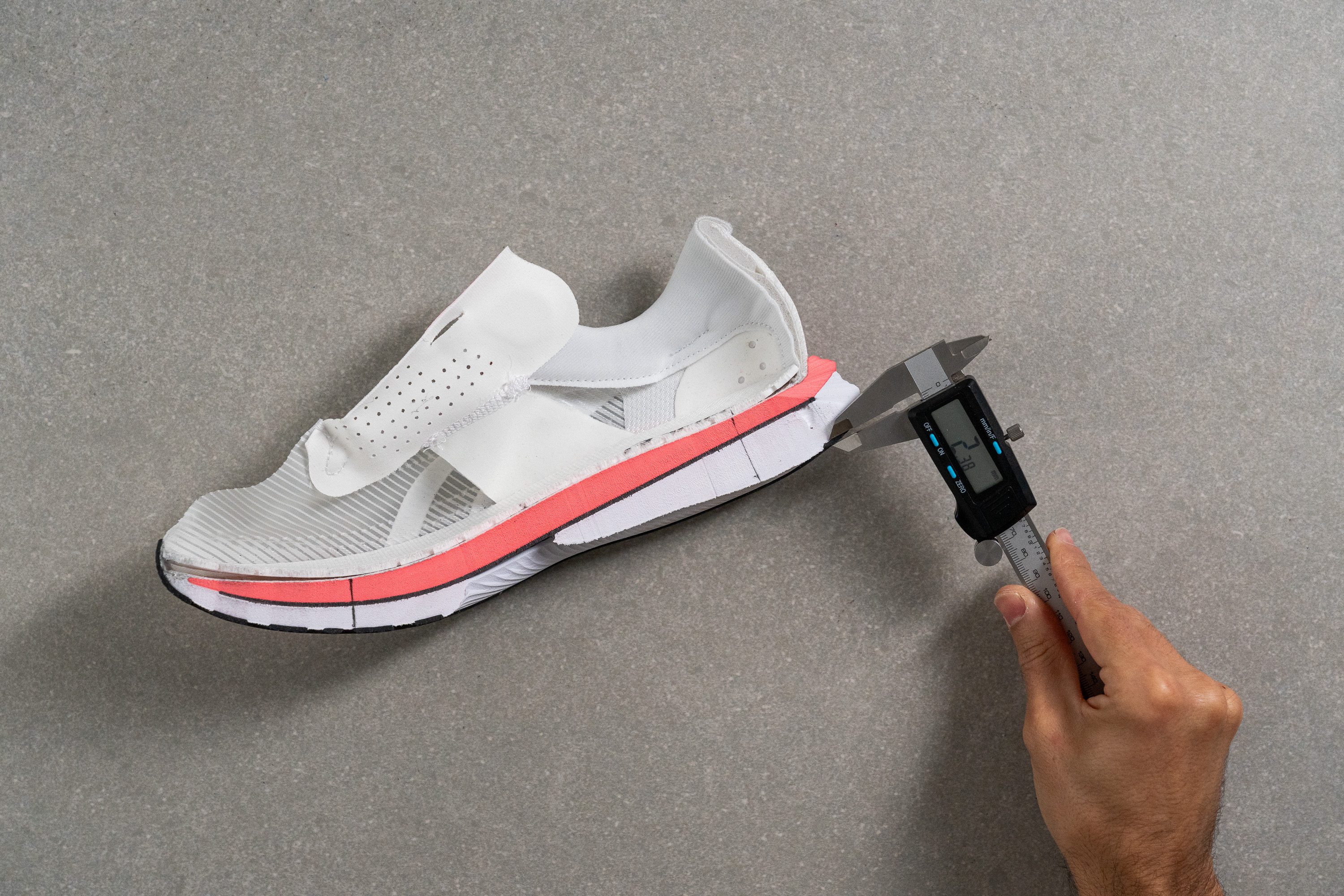
| Magic Speed 3 | 2.4 mm |
| Average | 3.2 mm |
Misc
Insole thickness
The insole is impressively thin at just 2.9 mm, aiming for significant weight reduction.
Plus, it's perforated for enhanced ventilation—a fantastic feature that only a few shoes offer and one we truly appreciate.
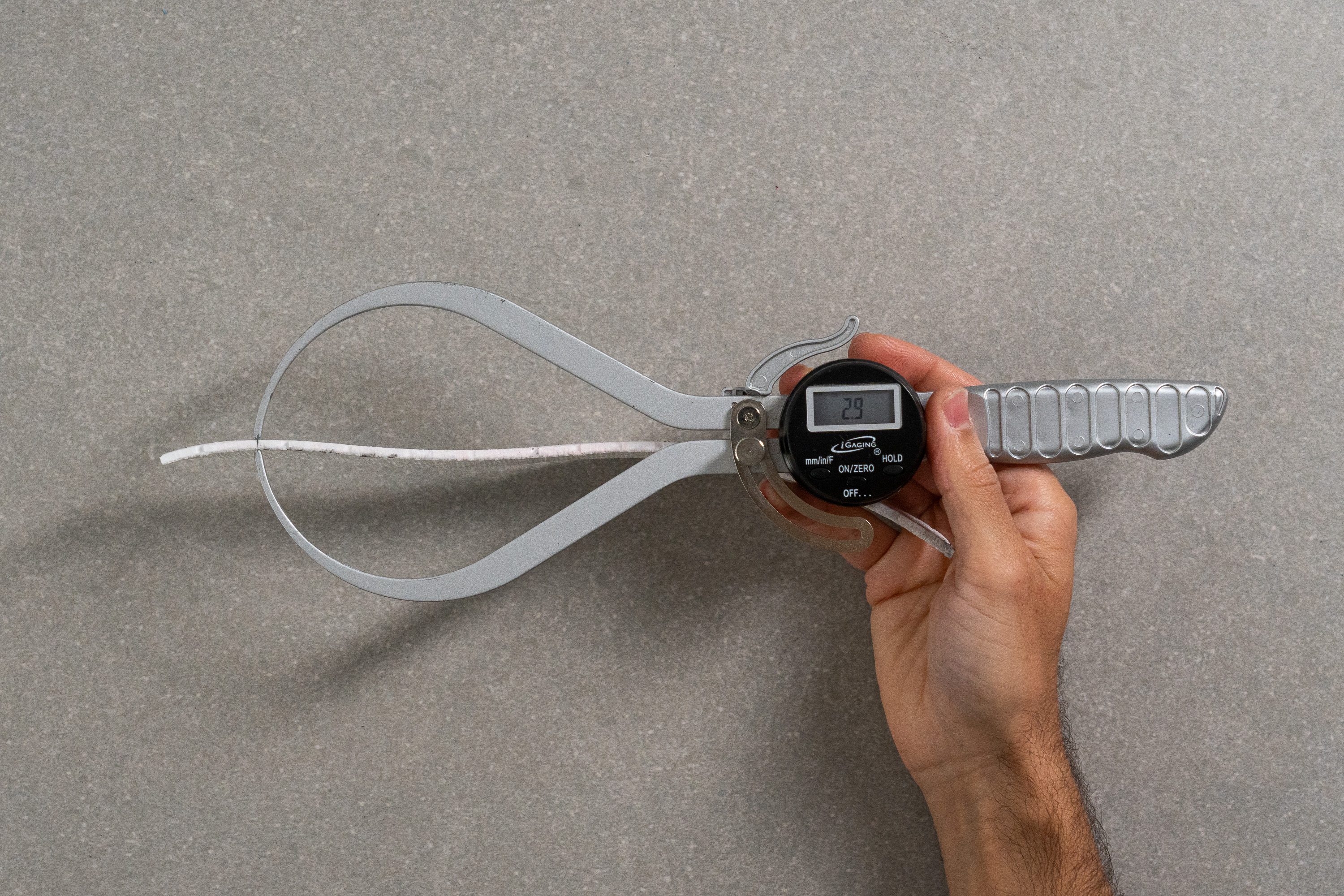
| Magic Speed 3 | 2.9 mm |
| Average | 4.5 mm |
Removable insole
You can switch out the insole in the Magic Speed 3 since it's not glued down.
But remember, the original insole is super thin and the heel is really narrow. So, if you pick a different one, make sure it's about the same thickness, or you'll end up with less space inside the shoe.
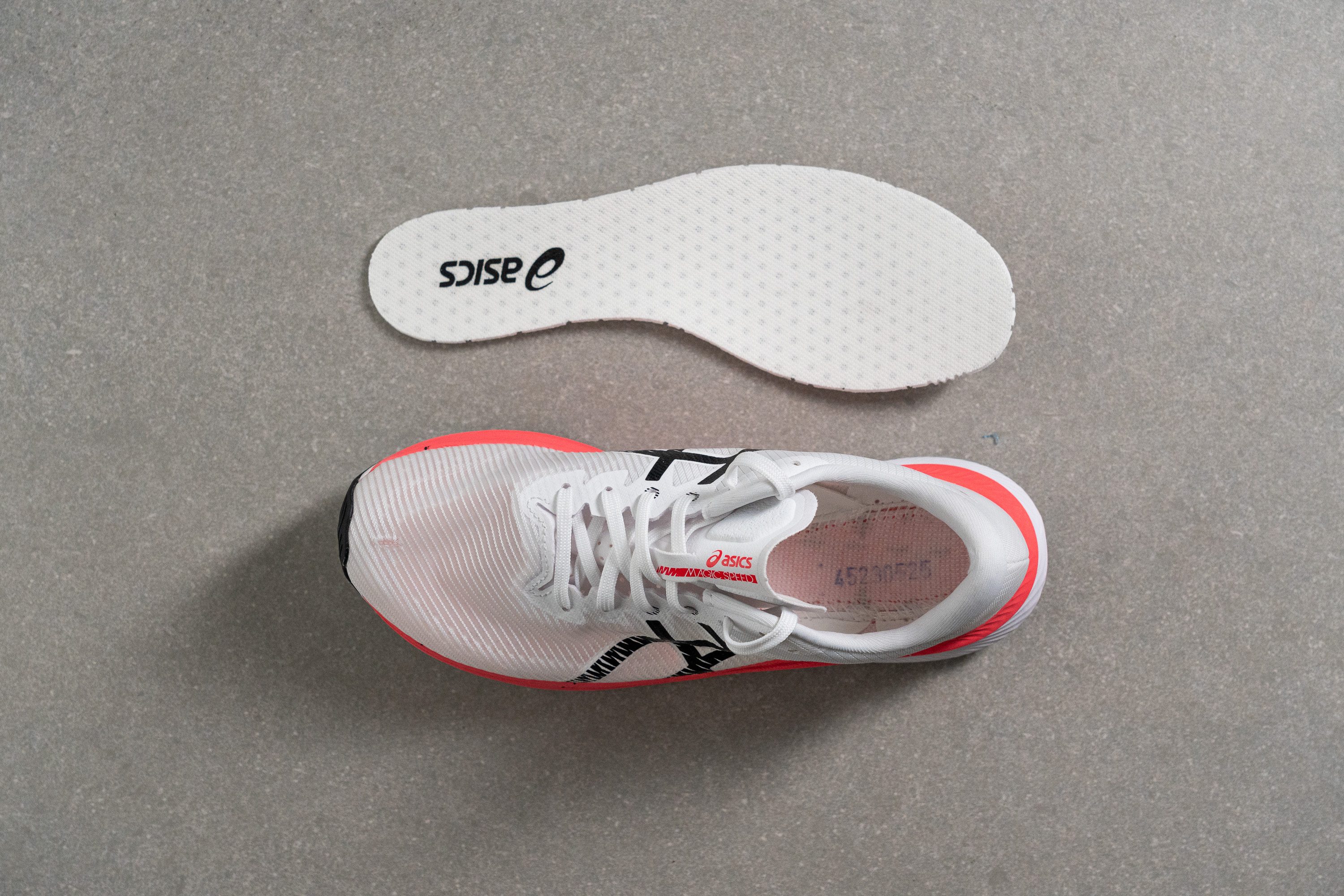
| Magic Speed 3 | Yes |
Midsole softness in cold
To see how the lower foam—the one that contacts the ground—behaves in cold temperatures, we placed it in our freezer for 20 minutes and then re-tested it with the durometer.
Now, it registered at 20.3 HA, which is almost the same.
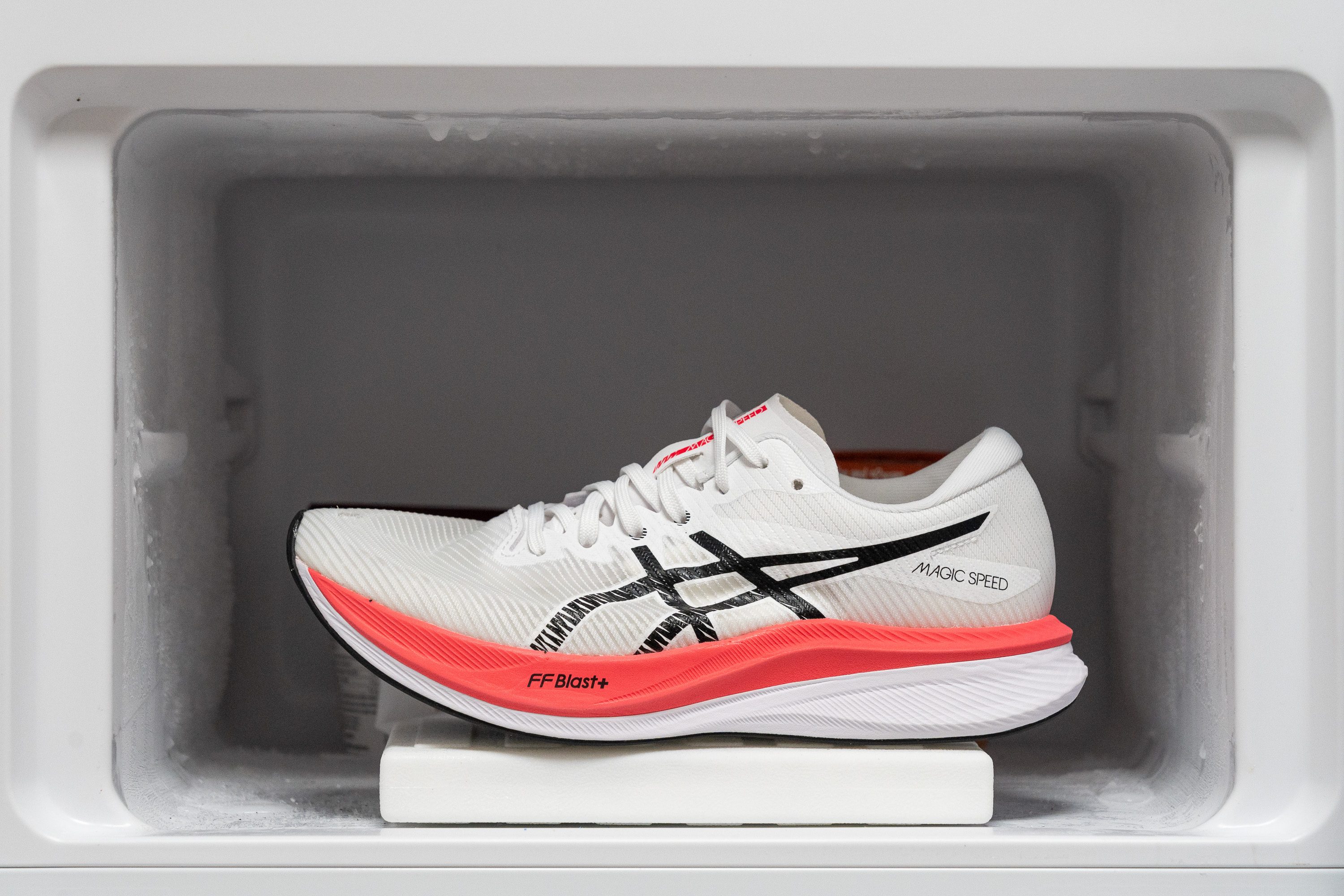
| Magic Speed 3 | 20.3 HA |
| Average | 25.2 HA |
Midsole softness in cold (%)
That's only an 11% increase, which is fantastic for an EVA-based foam. It seems that blending EVA with OBC (Olefin Block Copolymers) really paid off!
| Magic Speed 3 | 11% |
| Average | 24% |
Reflective elements
ASICS skipped the reflective elements on the Magic Speed 3, and honestly, we're pretty bummed about it. Maybe they'll add them in version 4?
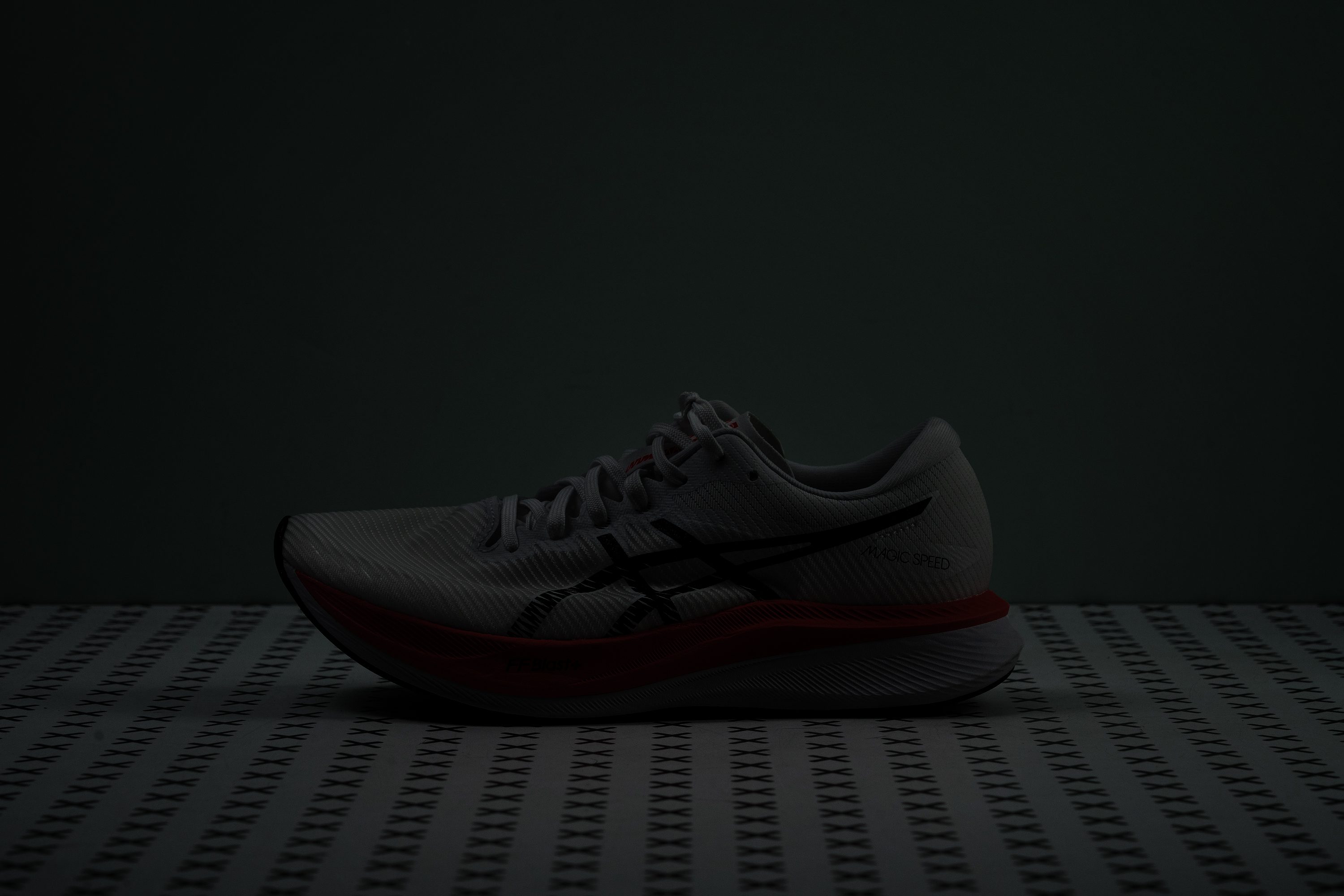
| Magic Speed 3 | No |
Tongue padding
With its 2.9 mm tongue padding, the MS3 hits a sweet spot.
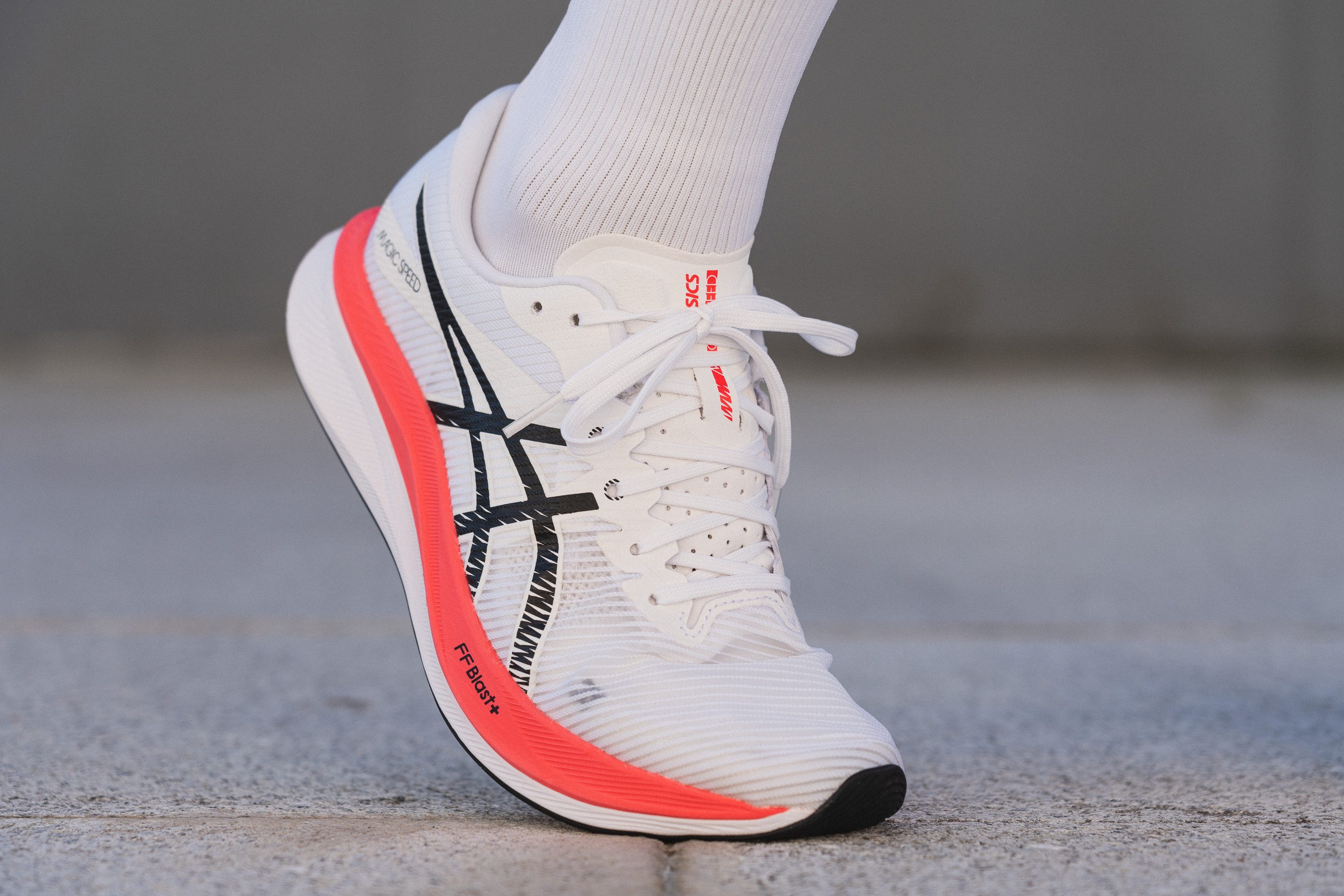
It's more cushion than what you'd find in a racing shoe—usually less than 1 mm—and less than in a training shoe, which often has over 5 mm.
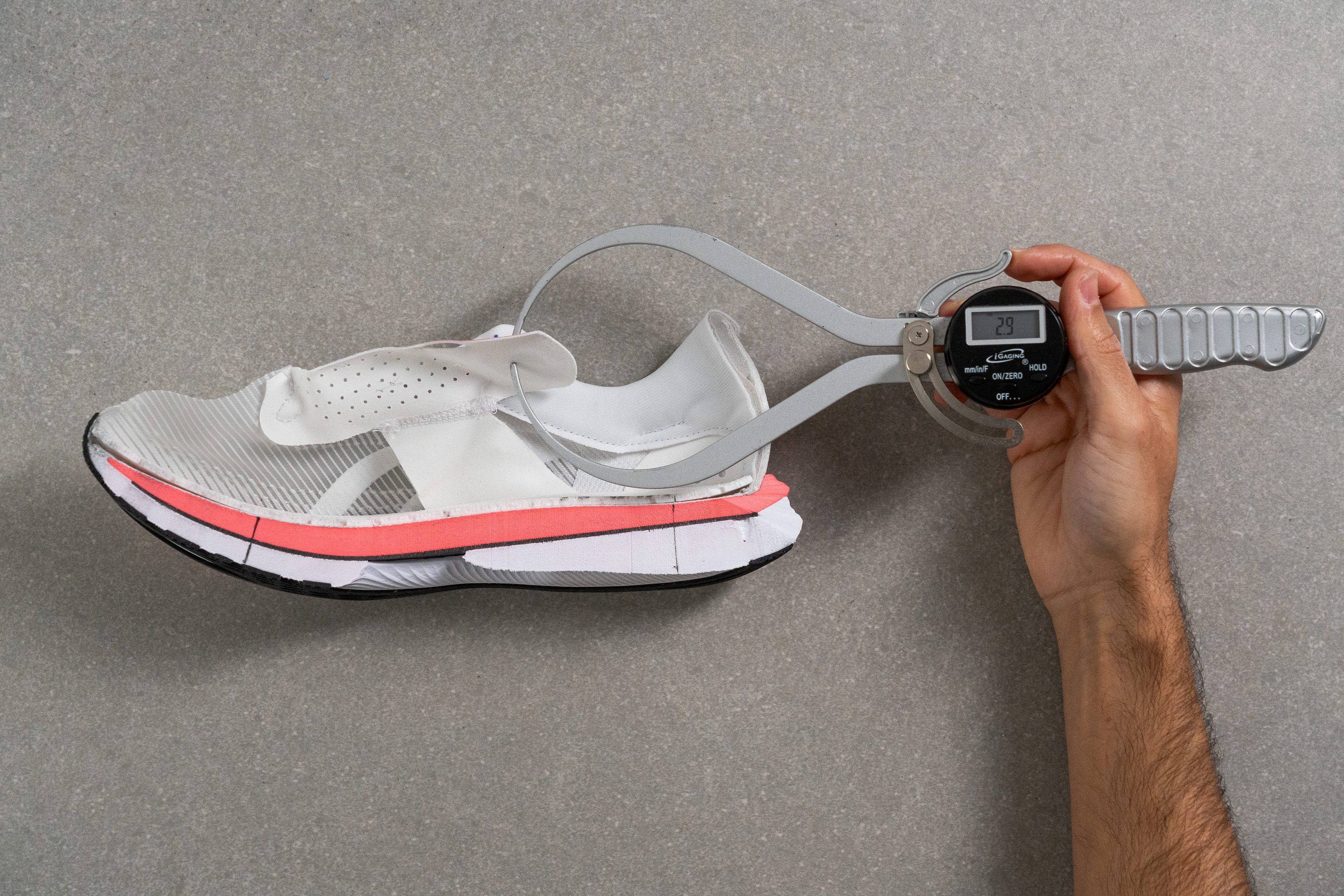
| Magic Speed 3 | 2.9 mm |
| Average | 5.8 mm |
Tongue: gusset type
The tongue is semi-gusseted, which we believe is the perfect approach for a shoe built for speed.
It doesn't add unnecessary bulk or weight inside the shoe, yet it greatly enhances the lockdown, ensuring a secure and comfortable fit.
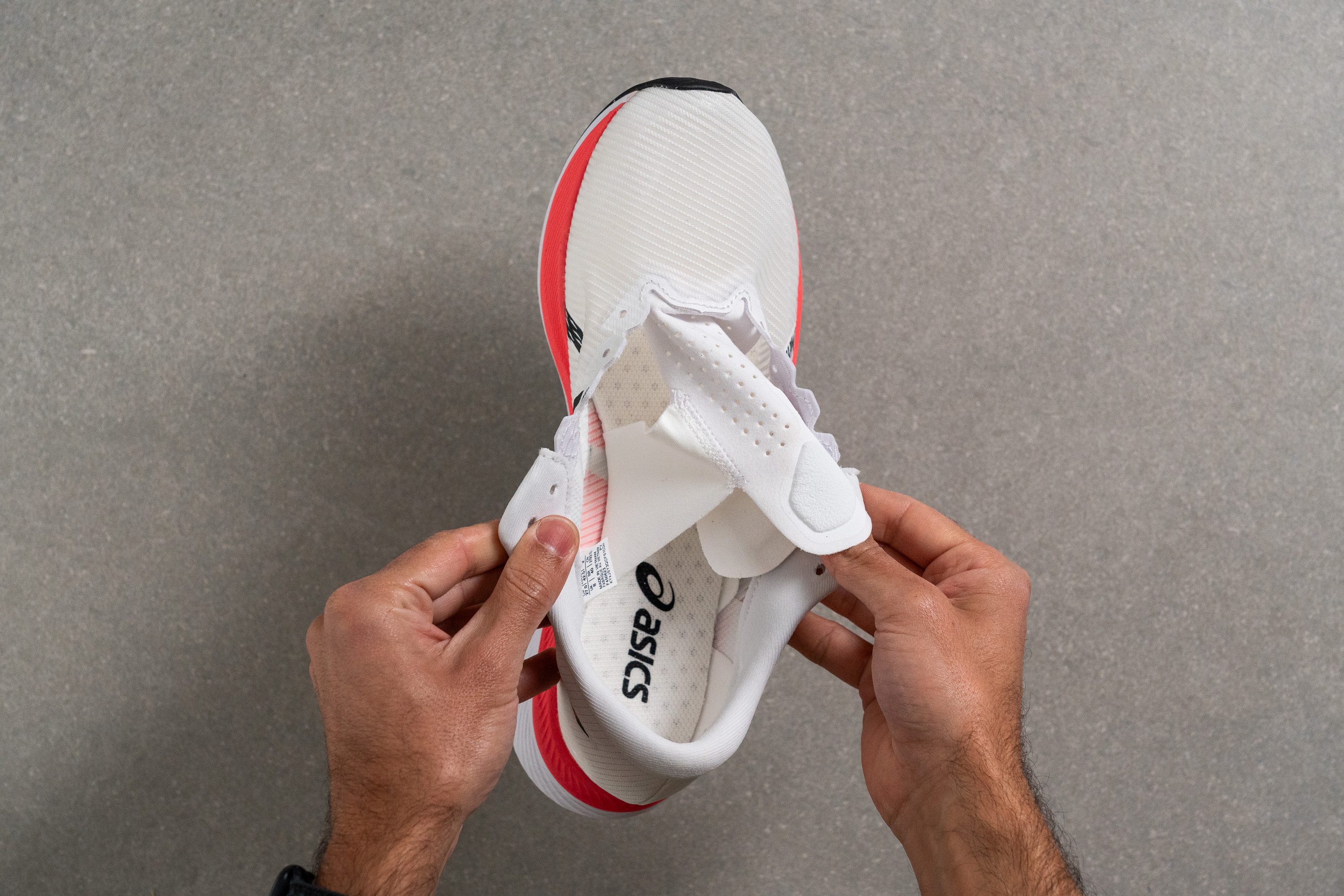
| Magic Speed 3 | Both sides (semi) |
Heel tab
Since it shares design cues with the ASICS Metaspeed series, the heel tab wasn't even in the cards.
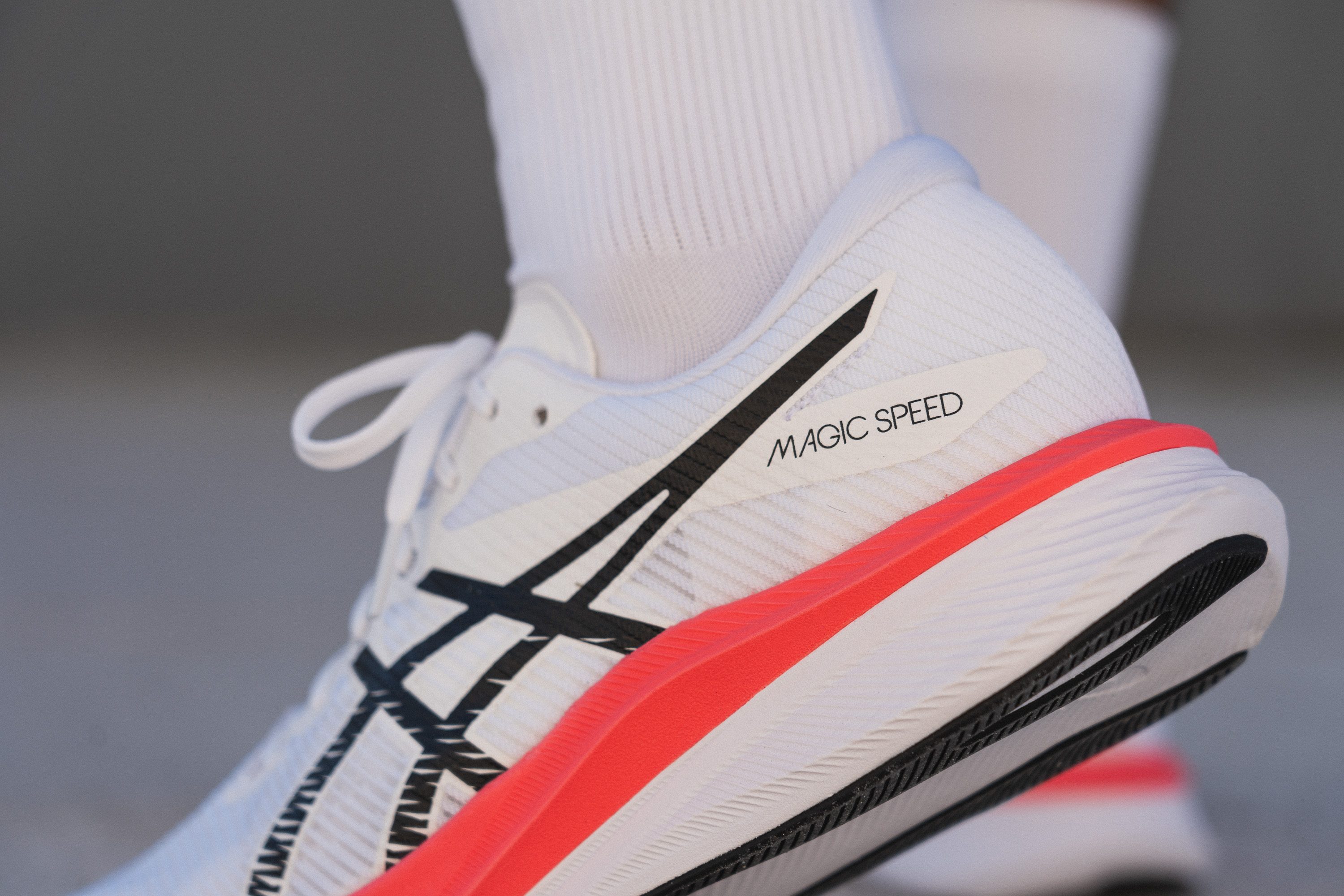
| Magic Speed 3 | None |

